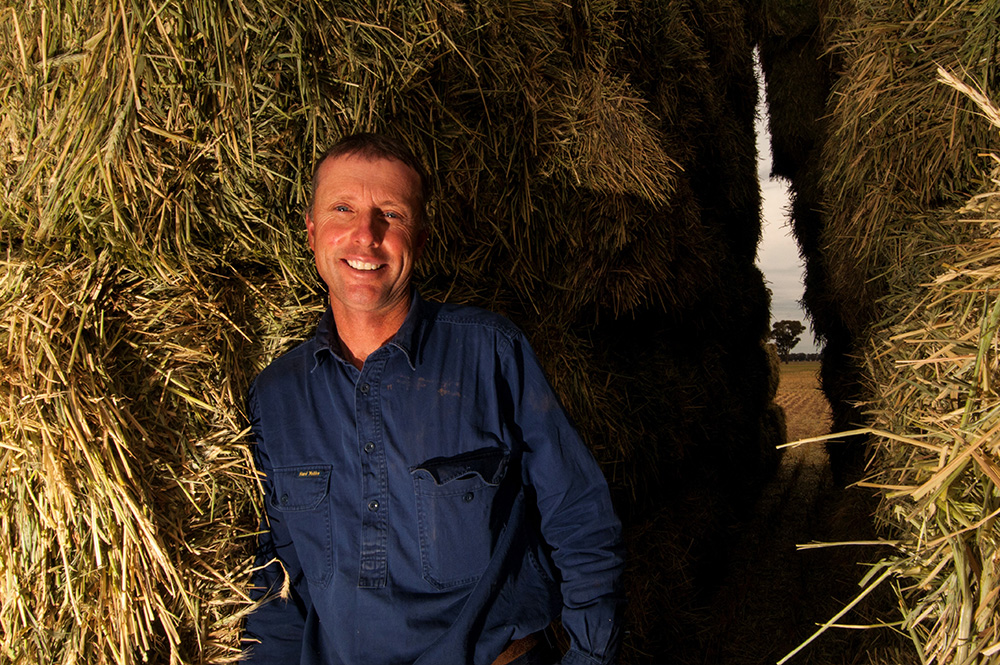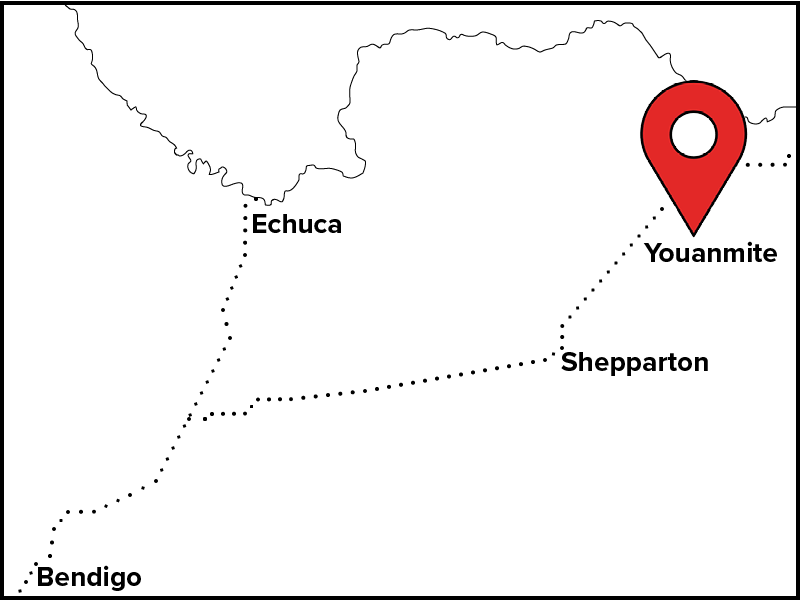Seasonal tools frame big picture vision


- Owners: Wayne and Terese Thomas
- Location: Youanmite, Victoria
- Farm Size: 1540 hectares, 1500 hectares cropping
- Average Annual Rainfall: 450 mm
- Soil Types: sandy loam over clay
- Soil pH: 5 to 6
- Typical Crops Grown: wheat, canola, oats, vetch, faba beans
Northern Victorian grower Wayne Thomas was busy loading wheaten and vetch hay onto trucks dusted with brittle soil in the dry heat when GroundCover visited his family’s 1540-hectare property at Youanmite, about 25 kilometres south-west of Yarrawonga.
Triggering this on-farm activity was the forecast for a soaking the following day, heralding a brief reprieve from the prolonged dry conditions during the 2018 growing season on the Thomas family’s farm.
Wayne’s risk management response to protect high-value hay from potential weather damage highlights the influence of increasingly sophisticated seasonal forecasting in helping to shield cropping operations from a changing climate and variable seasonal conditions.
However, seasonal forecasting is one of many tools the second-generation grower uses to frame a big-picture vision of the climatic and seasonal landscape that guides his approach to risk management across cereal, oilseed and legume crops grown for grain and hay.
'Each tool only assists with part of the overall picture, so we use a suite of tools to build the most accurate picture of our farm business risk profile,' he says.
For Wayne, these tools fit into the past, present and future of the farm’s cropping program: wheat, canola, oats, vetch and faba beans. They range from first-hand seasonal experience and paddock records to up-to-date soil moisture and weather data collected on-farm to seasonal and climatic forecasts, and a web-based decision support tool.
For example, he analyses data collected by a deep soil moisture probe and weather station installed on his property by Agriculture Victoria to help determine the yield potential of crops based on plant-available subsoil moisture and on-farm weather conditions.
From a fixed paddock location, the weather station records climatic information, such as in-crop temperature and received rainfall, while sensors in the capacitance probe record subsoil moisture at 10-centimetre increments from a depth of 30cm to one metre in the soil profile.
In the dry 2018 growing season, Wayne used data sourced from both the weather station and moisture probe on his property to help inform a key decision in farm business management — the decision to cut some wheat, canola, oats and vetch for hay instead of harvesting these crops for grain.
He says the weather station showed paddock temperatures, which plummeted from minus 1.3 to 6.2°C between 1am and 7am on 29 August, caused severe stem frost that saw cereal and oilseed crops 'frozen in time'.
'We’d never experienced frost like that before — in the past we’ve only had partial stem frost. Some of our wheat and oats didn’t grow another centimetre,' Wayne says.
The arrested crop development was reflected in the probe data that showed his frost-damaged wheat had stopped drawing moisture from the subsoil, suggesting it had stopped growing.
This frost impact on the Thomas family’s farm was also observed by Agriculture Victoria who manage a Victoria-wide network of probes and weather stations on growers’ properties and releases commentary based on the data collected.
Wayne’s inspection and monitoring of crops showed the severe frost damage was not limited to 350 hectares of wheat. It caused major damage to most of the farm’s 600ha of canola and 250ha of oats as well.
But he says lessons learnt from frost damage in past cropping seasons, plus in-crop examination, confirmed losses were less severe where crops were sown into legume stubbles.
This he attributes to the increased plant-available soil moisture following legume crops compared with cereals, and the dry conditions known to exacerbate frost-damage.
Apart from frost losses, other considerations that influenced Wayne’s decision to cut about two thirds of his crops for hay were short and long-term seasonal and climate forecasts, released by Agriculture Victoria.
To this end, he relies on seasonal forecast commentary, The Break, produced by Agriculture Victoria. The Break provides a range of seasonal forecast summary newsletters, comparing forecast models, including Bureau of Meteorology (BoM) models and soil moisture data for 3 to 6 months.
For instance, the short and long-term outlook in early September for continuing dry conditions saw Wayne cut some wheat and vetch for hay, even though it escaped frost damage, to help 'salvage profitability' from these moisture-stressed crops.
'Based on past experience, paddock data and seasonal forecasting, we know how much moisture crops need to fill grain.
'If there’s no moisture left in the soil profile and the seasonal outlook is hot and dry in September, it’s often safer to cut at-risk crops for hay than hang out for rain,' he says.
Chasing the 'most profitable, low risk' management option, he adds that forecast information is carefully measured against the backdrop of long-term yield averages and crop dry matter cuts that ranged from 1.7 to 2.5 tonnes/ha last year.
Wayne also fine tunes his crop area and inputs to match predicted seasonal conditions.
For instance, where seasonal climate models forecast low decile conditions, in which rainfall is ranked for each calendar year, and the probe on his property shows depleted subsoil moisture, Wayne might replace part of his wheat or canola area with less thirsty vetch or oaten hay enterprises.
'We don’t dramatically change our area planted to different crops in a dry season, but we may pull 100ha of wheat or canola from our program,' Wayne says. And he might adjust his nitrogen fertiliser application rates based on seasonal and climatic predictions of a dry season as well.
For example, in a high rainfall season, Wayne usually applies 30 to 50 kilograms of nitrogen/ha to help maximise grain productivity and profitability where cereals, with high yield potential, are sown into legume stubbles.
However, in the low rainfall 2018 growing season, no nitrogen fertiliser was applied to the farm’s stubble-sown cereals — a move that saw him secure better gross margins from parched crops, showing low yield potential.
Wayne’s seasonal risk management toolbox also comprises the web-based decision support tool, Yield Prophet®, used to estimate crop yield potential based on predicted rainfall and soil core testing, plus BOM Indian Ocean Dipole outlooks known to influence on-farm rainfall.